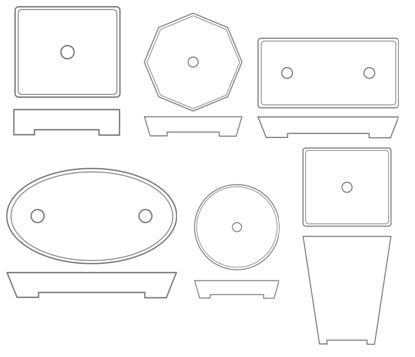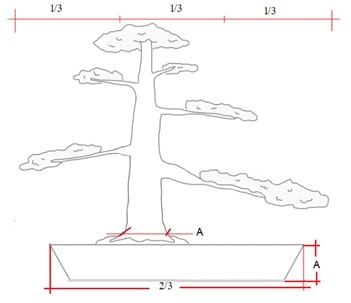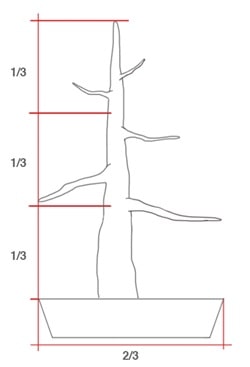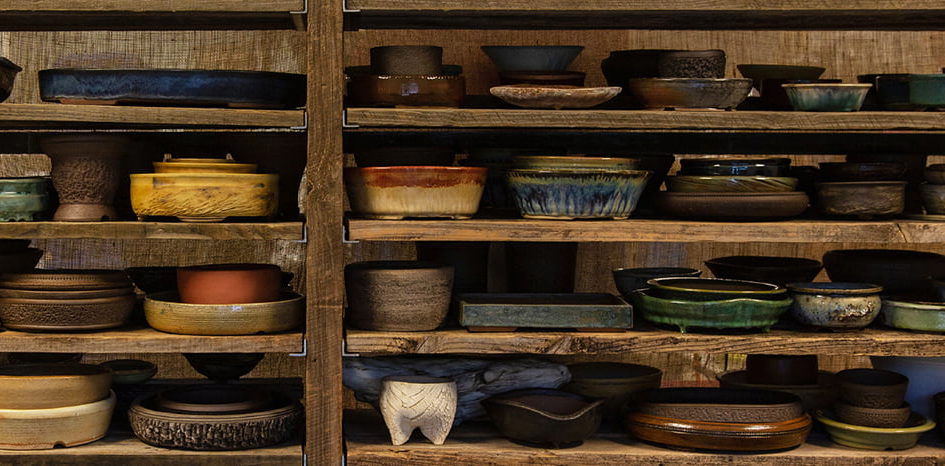To give the bonsai its finished shape, it is necessary to choose an appropriate container for it. The container and the plant should harmoniously complement each other. The container should be simple and plain. A brightly colored or overly beautiful antique pot is too eye-catching and less suitable for bonsai. In bonsai culture, the focus should primarily be on the plant, with the container being of secondary importance.
A container for bonsai is usually made of clay. (In the early stages of formation, a plastic container or other vessel may be used.) Recently, containers made of mica (MICA) have become very popular. A container made from this material is not easily broken, withstands frost well, and is cheaper than a classic clay container.
A clay container is better if it is fired on the outside. Such a container is more beautiful and durable, but the inside should definitely be without glazing.
The container must have a drainage hole. If the container is quite large, it requires two or more drainage holes. After watering, if water accumulates anywhere at the bottom of the container, it will inevitably cause part of the plant's roots to rot. To prevent this, carefully observe the container, and if you think the drainage holes are insufficient or too small, expand them or make additional holes.
The container must have feet, at least half a centimeter high. Why are feet necessary? After watering, water comes out of the drainage holes. If the container does not have feet, moisture will remain between the bottom of the container and the surface it rests on for a long time. The plant’s roots try to grow as deep as possible into the soil, and therefore they will inevitably come out of the drainage hole. Roots that emerge quickly decay and become a breeding ground for diseases and pests. Also, harmful insects gather under a container without feet and easily enter the container through the drainage holes.
The selection of a container for each bonsai is done individually. It is necessary to adhere to specific proportions and color matching. Of course, if we plant a small plant in a large container or if the color of the container does not match the plant, the plant will not wither, but ultimately, we will not achieve what every bonsai enthusiast strives for: a unified, impressive look of the container and the plant, which is called a beautiful and refined bonsai. If the shape, size, and color of a well-chosen container make the bonsai's overall appearance more effective, a plant placed in an unsuitable container, even if it is the most beautiful tree, loses much in terms of aesthetics.
There are many containers made worldwide, in various sizes, shapes, and colors. But selecting the right container from them that perfectly matches your bonsai is not an easy task. The final decision is still up to the bonsai enthusiast's taste, but beginners must be aware of certain criteria for choosing a suitable container for bonsai.
Shape
The container can be square, multi-angular, rectangular, oval, or round. For cascade and semi-cascade styles, a tall container is used.

It is desirable to choose a container with an appropriate shape for every style of bonsai. Styles that consist of a single tree can be placed in containers of all shapes. In bonsai styles that have multiple trunks or a group of trees ( Nezunagari, Ikadabuki, Yose Ue), it is desirable to place them in rectangular or oval, less deep containers. For these styles, a flat stone-like surface with asymmetrical sides can be used. Such a container is also needed for styles like Sekidzeiju and Ishizuki. For the style Bunjingi, typically only small round containers are used. For the styles Kengai, Han-Kengai, a tall container is essential to balance a tree that leans to one side. Kengai style bonsai often has branches that grow below the container’s base. In this case, the bonsai is placed on a high stand.
Color
The choice of container color is quite subjective. However, it is desirable for the container to have a "non-flashy," neutral color: gray, dark and light green, brown, reddish clay color. White and dark blue containers also look beautiful. There are also containers in red, blue, and yellow colors. Many experts choose the container color based on the plant species. For example, neutral colors are selected for coniferous and deciduous trees, while red, yellow, and blue containers are preferred for fruiting and flowering trees.
Size
The selection of the container size depends on the size of the bonsai itself. There is a certain basic proportion between the size of the plant and the container. The height of the container should be equal to the thickness of the bonsai trunk at the roots. For trees with widely spreading branches, where the widest part of the canopy exceeds the height of the bonsai, the length of the container should be 2/3 of the width of the widest part of the canopy. In this case, it is permissible for the container height to be slightly lower.


If the bonsai is tall (height is greater than the width of the canopy at its widest point), the length of oval and rectangular containers should be 2/3 of the height of the bonsai. In the case of round containers, the diameter should be 1/3 of the bonsai's height. Similarly, for square containers, the side length should also be 1/3 of the plant's height.In bonsai styles where multiple trees are planted together, the length of the container should be 2/3 of the height of the tallest tree.
The width of rectangular containers should be approximately 70-75% of their length. In oval containers, the widest point should be 70% of the length.If the tree has a very thick trunk relative to its height, it is preferable to place the plant in a slightly taller container.Some conifers (such as cedar, pine) may dry out if their roots are pruned too much. Therefore, it would be good to break the ~ideal~ proportions for these plants and place them in a “higher than normal” container.
For the Kengai and Han-Kengai styles, selecting the correct container size is probably the most difficult. As a rule, these styles require tall and narrow containers. The exact size depends entirely on the bonsai creator's taste. A shorter container can also be used. In this case, the bonsai is placed on a special high stand.

